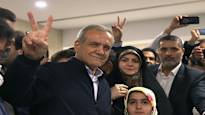The result of the presidential election in Iran indicates widespread dissatisfaction among the country’s conservatives as well.
16:45•Updated 17:19
Recently, life in Iran has been going from crisis to crisis. First, in January, Iran carried out airstrikes on the territories of Iraq, Syria and Pakistan. Then the attacks between Israel and Iran began. Iranians feared that their country would drift directly into war. However, it was avoided.
In May, the president of Iran Ebrahim Raisi died suddenly in a helicopter crash. Early elections were announced immediately after five weeks.
Last night, for the first time in a while, the country saw a celebration in the streets: a reform-minded presidential candidate Masoud Pezeshkian won the second round of the election.
Although the turnout was still low (around 50 percent), it still increased from last week: the first round of the election only got slightly less than 40 percent of eligible voters to the ballot box. It was the lowest reading since Iran’s Islamic Revolution in 1979, which turned the country into a strict Shiite Islamic state.
The most interesting thing about Pezeshkian’s victory is that it also says a lot about the dissatisfaction of Iranian conservatives with the country’s situation.
Many eligible voters still stayed at home, and normally such a setup would have favored the Conservative candidate, in this case Saeed Jalilia. Opponents of the Islamic Republic of Iran have boycotted the elections, as they have not felt that even reformists can bring about enough change in a country where the ultimate decision-making power rests with the country’s supreme leader, the Ayatollah with Ali Khameneithe Revolutionary Guard and the Council of Religious Scholars.
This time the result tells a different story.
All the more obviously, many conservative Iranians turned to vote for Pezeshkian or ended up abstaining from the ballot box altogether. Many also certainly wanted to prevent Jalil, who represented the extreme, from coming to power – there were fears in the country that he would drive Iran into an even more explosive situation. Jalili was also not a candidate favored by the administration – it had already fallen in the first round Mohammad Bagher Ghalibaf.
In the last elections, reformists were not even allowed to run – the conservatives’ stranglehold on the administration only tightened.
This time, according to experts, the economy was the biggest concern for people. The sanctions imposed by the United States on the country are the strictest in the world and have made life difficult for ordinary people.
Also in 2022, a 22-year-old who died at the hands of the chastity police Mahsa Amini and the large demonstrations that followed the incident against the administration’s forced use of headscarves had an effect. As always, the regime responded to the protests with a heavy hand: around 500 died in police violence, thousands were arrested and eventually seven were executed.
The last time a reformist president won the elections in Iran was in 2013, when Hassan Rouhani came to power. Even then, a few years earlier, large demonstrations against the administration had been seen.
The country’s leadership probably now calculated that it is only possible to appease widespread discontent with a reform-minded candidate.
During the Rouhani era, Iran was able to negotiate a nuclear deal with the US and the EU. We were getting out of the economic sanctions, until Donald Trump came to power in the United States and withdrew from the agreement.
Contrary to popular belief, in Iran it is possible to influence the country’s politics to some extent by voting, within certain, albeit very strict, limits.
How many changes are known now?
Among other things, Pezeshkian has been loudly supported by a former foreign minister known from Rouhani’s era Javad Zarifwhich played a key role in the nuclear negotiations.
The same faces will surely be seen again in the administration, and Iran’s tone of voice towards the West will surely become a degree softer.
Pezeshkian has expressed his desire to start direct negotiations with the West again – whether Trump or Joe Biden.
During the Rouhani era, the power of the chastity police was also reduced. This can be assumed to happen even now.
During his campaign, Pezeshkian also said that he wants to relax strict online censorship – in the country, almost all social media platforms are currently blocked.
Still, it must be remembered that Iran’s regional policy in particular is not under the president’s discretion. Therefore, we will hardly see any changes in the relationship between Israel and Palestine. The same can be assumed for Lebanon, Yemen and Syria.
Iran will continue to rely on its allies, i.e. the so-called axis of resistance in the Middle East.
Pezeshkian has also been described as a moderate reformer. What he will achieve in the country in the next few years will certainly not be enough for many who have opposed the regime in the streets in recent years.
